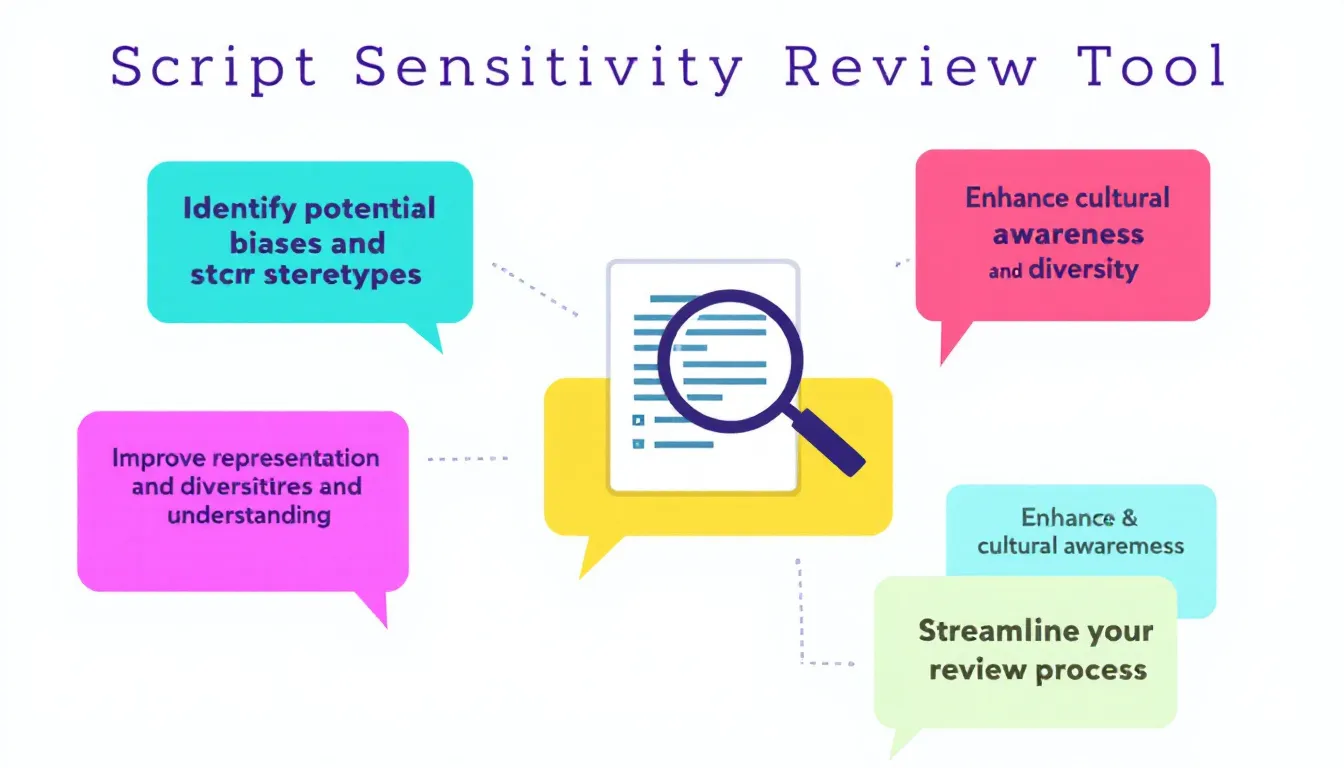Script Inclusivity and Sensitivity Review
Is this tool helpful?
How to Use the Script Sensitivity Review Tool Effectively
To make the most of our Script Sensitivity Review Tool, follow these simple steps:
- Enter Your Script: In the first text area labeled “The script to be reviewed for inclusivity and sensitivity,” paste your entire script. For example, you could input a movie script about a diverse group of friends organizing a community event.
- Specify Target Audience (Optional): In the “Target Audience” field, enter the intended audience for your script. For instance, you might enter “Young adults aged 18-25 from diverse backgrounds.”
- Define Genre (Optional): In the “Genre” field, specify the type of script you’re submitting. An example could be “Coming-of-age comedy-drama.”
- Submit for Review: Click the “Review Script” button to initiate the sensitivity analysis.
- Review Results: Once processed, the tool will display a comprehensive review below the form. This will include feedback on potential sensitivity issues and suggestions for improvement.
- Copy Results: Use the “Copy to Clipboard” button to easily save and share the review results.
Empowering Inclusive Storytelling: The Script Sensitivity Review Tool
In today’s diverse and interconnected world, creating inclusive and respectful content is more important than ever. The Script Sensitivity Review Tool is an innovative solution designed to help writers, filmmakers, and content creators ensure their scripts are free from unintended biases, stereotypes, or potentially offensive material. By leveraging advanced natural language processing and machine learning algorithms, this tool provides comprehensive feedback on inclusivity and sensitivity issues, helping creators craft more authentic and respectful narratives.
The Power of Inclusive Storytelling
Inclusive storytelling is not just about avoiding offense; it’s about creating richer, more authentic narratives that resonate with diverse audiences. By considering the perspectives and experiences of different groups, creators can:
- Develop more complex and relatable characters
- Explore nuanced themes and storylines
- Reach wider audiences and increase engagement
- Contribute to positive social change and understanding
Our Script Sensitivity Review Tool is designed to support these goals by providing valuable insights and suggestions to enhance the inclusivity of your scripts.
Benefits of Using the Script Sensitivity Review Tool
1. Enhanced Awareness and Learning
One of the primary benefits of using this tool is the opportunity for continuous learning and improvement. As you receive feedback on your scripts, you’ll develop a keener awareness of potential sensitivity issues, helping you become a more mindful and inclusive writer over time.
2. Time and Resource Efficiency
Manual sensitivity reviews can be time-consuming and costly, often requiring multiple readers with diverse perspectives. Our tool streamlines this process, providing quick and comprehensive feedback that can save valuable time and resources during the script development phase.
3. Consistency in Review Process
The tool applies consistent criteria across all scripts, ensuring that each piece of content receives thorough and unbiased analysis. This consistency helps maintain high standards of inclusivity across all your projects.
4. Reduced Risk of Controversy
By identifying potential issues early in the writing process, the tool helps mitigate the risk of creating content that could lead to public backlash or controversy. This proactive approach can protect your reputation and prevent costly rewrites or reshoots.
5. Improved Audience Reception
Scripts that have undergone sensitivity review are more likely to resonate positively with diverse audiences. This can lead to better reception, increased engagement, and potentially broader commercial success for your projects.
Addressing User Needs and Solving Specific Problems
The Script Sensitivity Review Tool addresses several key challenges faced by content creators in today’s diverse media landscape:
1. Identifying Unconscious Bias
Even well-intentioned writers can inadvertently include biased language or stereotypes in their work. Our tool helps identify these instances, allowing creators to address unconscious biases they may not have been aware of.
Example:
A writer submits a script for a workplace comedy. The tool identifies that all leadership roles are assigned to male characters, while female characters are predominantly in supportive roles. This feedback allows the writer to reassess and diversify the character dynamics, creating a more balanced and realistic representation of a modern workplace.
2. Navigating Cultural Sensitivities
In an increasingly globalized world, it’s crucial to be aware of cultural sensitivities that may not be immediately apparent to writers from different backgrounds. The tool helps identify potential cultural misrepresentations or insensitivities.
Example:
A screenwriter working on a historical drama set in a South Asian country includes several scenes depicting local customs. The tool flags potential inaccuracies in the portrayal of religious practices, prompting the writer to conduct further research and consult with cultural experts to ensure authenticity.
3. Ensuring Inclusive Language
The tool helps writers use more inclusive language by identifying outdated terms, gendered language, or phrases that may exclude certain groups.
Example:
In a sci-fi script, the tool highlights the frequent use of “mankind” and suggests alternatives like “humankind” or “humanity” to be more inclusive. It also notes the use of binary gender pronouns for alien species and recommends considering neutral alternatives to avoid projecting human gender norms onto non-human characters.
4. Avoiding Harmful Tropes and Stereotypes
Many writers unknowingly perpetuate harmful tropes or stereotypes in their work. The Script Sensitivity Review Tool helps identify these issues, allowing writers to subvert or avoid them altogether.
Example:
In a romantic comedy script, the tool identifies that the protagonist’s best friend character falls into the “Gay Best Friend” trope, lacking depth or storylines unrelated to the main character’s love life. This prompts the writer to develop this character further, giving them their own arc and more nuanced representation.
Practical Applications and Use Cases
1. Film and Television Production
Production companies can integrate the Script Sensitivity Review Tool into their development process, ensuring that scripts are vetted for inclusivity before moving into production. This can help avoid costly reshoots or public relations issues that might arise from insensitive content.
Example Scenario:
A major studio is developing a high-budget superhero film. By running the script through the sensitivity review tool, they identify that the villain’s physical disability is being used as a shorthand for evilness, perpetuating harmful stereotypes. The writers revise the character, focusing on their motivations and backstory rather than physical attributes, resulting in a more nuanced and less problematic antagonist.
2. Educational Content Creation
Educators and educational content creators can use the tool to ensure their materials are inclusive and respectful to all students, regardless of their background.
Example Scenario:
A team developing a new history textbook uses the tool to review their chapters. The review highlights an overemphasis on European perspectives in global historical events. This feedback allows the team to incorporate more diverse viewpoints and create a more balanced and comprehensive educational resource.
3. Advertising and Marketing
Marketing teams can use the tool to review scripts for commercials, ensuring their advertisements are inclusive and avoid unintentional offense.
Example Scenario:
An advertising agency is creating a campaign for a new line of fitness products. The script review tool identifies that the ad relies heavily on unrealistic body standards and potentially triggering language around weight loss. The team revises the script to focus on health, strength, and individual progress, creating a more inclusive and positive message.
4. Video Game Development
Game developers can use the tool to review scripts for character dialogue, cutscenes, and narrative elements, ensuring their games are inclusive and appealing to a diverse player base.
Example Scenario:
A team developing a role-playing game set in a fantasy world uses the tool to review their main quest dialogue. The review highlights that female characters are often depicted as needing rescue, while male characters drive the plot. The writers revise the script to give agency and complex motivations to characters of all genders, creating a more balanced and engaging narrative.
5. Corporate Communications
Companies can use the tool to review internal and external communications, ensuring that their messaging is inclusive and aligns with their diversity and inclusion goals.
Example Scenario:
A multinational corporation is preparing a speech for their annual shareholders’ meeting. The sensitivity review tool identifies language that could be interpreted as ageist when discussing workforce dynamics. The communications team revises the script to focus on skills and experience rather than age, promoting a more inclusive message about their diverse workforce.
Frequently Asked Questions (FAQ)
1. How does the Script Sensitivity Review Tool work?
The tool uses advanced natural language processing and machine learning algorithms to analyze scripts for potential sensitivity issues. It compares the content against a comprehensive database of inclusive language, cultural information, and known stereotypes to provide detailed feedback and suggestions.
2. Can the tool review scripts in languages other than English?
Currently, the tool is optimized for English-language scripts. However, we are actively working on expanding our capabilities to include other languages in the future.
3. How long does it take to review a script?
The processing time depends on the length and complexity of the script. Typically, reviews are completed within a few minutes for shorter scripts, while longer or more complex scripts may take up to 10-15 minutes.
4. Can the tool review other types of content besides scripts?
While the tool is optimized for script formats, it can also provide valuable insights on other forms of written content such as articles, blog posts, or marketing copy. However, the feedback may be less specific to script-related elements in these cases.
5. Is the tool a replacement for human sensitivity readers?
The Script Sensitivity Review Tool is designed to complement, not replace, human sensitivity readers. It provides a valuable first pass to identify potential issues, but we always recommend following up with human readers, especially those from the communities represented in your content, for more nuanced feedback.
6. How often is the tool updated?
We regularly update our tool to reflect evolving language norms, cultural understanding, and user feedback. Major updates are typically released quarterly, with minor improvements and database updates occurring more frequently.
7. Can I use the tool for academic research on inclusive writing?
Absolutely! Many researchers find our tool valuable for studying trends in inclusive writing and the evolution of sensitivity in media. We offer special access packages for academic institutions interested in using the tool for research purposes.
8. How does the tool handle context-dependent sensitivity issues?
The tool is designed to consider context when analyzing scripts. However, it may sometimes flag items that are appropriate in certain contexts. This is why we provide detailed explanations with our feedback, allowing users to make informed decisions based on their specific context and artistic vision.
9. Can the tool help with improving representation of specific groups?
Yes, the tool can provide feedback on the representation of various groups, including racial and ethnic minorities, LGBTQ+ individuals, people with disabilities, and more. It can highlight areas where representation might be lacking or where characters from these groups might be portrayed in stereotypical ways.
10. Is there a limit to how many scripts I can review?
The number of scripts you can review depends on your subscription plan. We offer various plans to suit different needs, from individual writers to large production companies. Check our pricing page for more details on available plans and their features.
By leveraging the power of the Script Sensitivity Review Tool, content creators can navigate the complexities of inclusive storytelling with greater confidence and effectiveness. This innovative tool not only helps avoid potential pitfalls but also encourages the creation of richer, more authentic narratives that resonate with diverse audiences. As we continue to strive for more inclusive and representative media, tools like this play a crucial role in supporting creators in their quest to tell stories that truly reflect the diversity of our world.
Important Disclaimer
The calculations, results, and content provided by our tools are not guaranteed to be accurate, complete, or reliable. Users are responsible for verifying and interpreting the results. Our content and tools may contain errors, biases, or inconsistencies. We reserve the right to save inputs and outputs from our tools for the purposes of error debugging, bias identification, and performance improvement. External companies providing AI models used in our tools may also save and process data in accordance with their own policies. By using our tools, you consent to this data collection and processing. We reserve the right to limit the usage of our tools based on current usability factors. By using our tools, you acknowledge that you have read, understood, and agreed to this disclaimer. You accept the inherent risks and limitations associated with the use of our tools and services.







